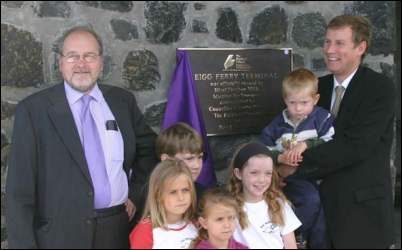
Cllr king (left) and Nicol Stephen MSP with Eigg children
ISLANDS' FERRY TERMINALS 'OPENED'
Weather conditions were close to perfect as Minister for Transport Mr Nicol Stephen MSP officially opened Phases 1 and 2 of the Small Isles Ferry Terminal Project.
Eigg and Muck were visited on this day - Tuesday 31st August - and although Rum could not be visited they were not forgotten with the Muck school children unveiling the Rum plaque at the same time as they helped Mr Stephen unveil the one for Muck.
'The Small Isles face long term challenges, one of them being depopulation,' said Mr. Stephen in his opening address, 'but investment in transport links is one of the key ways we can increase prosperity, support island life and encourage more young people to remain on the islands.
'Today is a great day for the people of Eigg, Muck and Rum, and I can assure you that the Scottish Executive is committed to improving lifeline services throughout the Highlands and Islands.'
It's hard to argue with that statement from Mr. Stephen as once Phase 3 (the new ferry terminal at Inverie, which is currently underway) and Phase 4 (improvements to Canna Pier) have been completed, a sum in excess of £30 million will have been spent on the project through a combination of Scottish Executive and European funding.
Councillor Charlie King brought official procedures to a close by thanking everyone for all their efforts towards what has been achieved so far, but pointing out that there is more to be done, including a re-evaluation of freight and passenger service charges to the Small Isles.
The new terminals will revolutionise life on the islands, enabling islanders and supply vehicles to drive on and off the islands, with an end to the sometimes hazardous use of flit boats.
MORAR GETS GOOD SCHOOL REPORT
Lady Lovat Primary School has been praised by HM Inspectors of Education for the leadership and effective team work, the very high standard of education provided and its well balanced curriculum, good teaching and relationship with the wider community.
WHO'S MAKING WAVES?
Mo Mathieson's great photo of the humpback whale has appeared in several of the national papers.
Mo's photos were taken from Mark Rodgers boat Blue Badger.
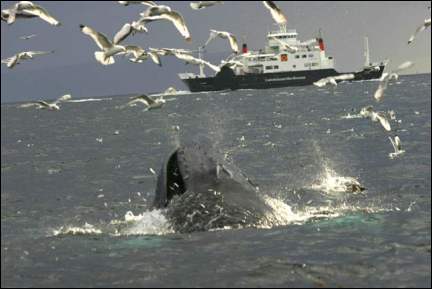
Humpback whale sighted off Mallaig
Most people in Mallaig know there are Minke whales to be seen regularly in the waters off the town, as well as occasional visits from bottlenose dolphins and basking sharks. But what about humpback whales?
Having spent several years conducting marine life surveys in the Western Isles, no-one knows better than I do that you can expect the unexpected in these wildlife rich waters, so when several visitors reported sighting a humpback off Mallaig, we did all we could to look out for the whale during our first basking shark surveys.
Our luck didn't hold, though, and we were disappointed in our efforts, although we did record many Minkes, until the crew of the Hebridean Whale and Dolphin Trust survey vessel Silurian kindly passed us details of the last position where they had sighted the whale. So we took the opportunity to pass through that area the next time we left port.
And there it was - a young humpback of up to 9m in length, surrounded my vast mats of seabirds, all making a remarkable racket. Every so often the whale would launch itself up through the birds, sending them scattering skywards. This feeding strategy, known as lunge feeding, where the whale erupts through the surface, scooping up huge quantities of water and small fish in its huge pleated throat, before forcing the water out through its baleen plates, saving the fish, can be a messy business, hence the presence of the birds competing for the scraps.
For 45 minutes we watched from a safe distance as the whale went through a repertoire of side breaches and repeated lunges, until the light was almost gone, and the sun sank slowly behind Rum - a magical experience.
So is there any significance in the whale being here? It's difficult to say, although humpbacks do seem to have been seen more regularly in recent years around the UK, but a far more regular pattern of sightings may have to be established before any firm conclusion could be drawn. But wouldn't it be marvellous if they were to re-colonise these waters, and we could regularly watch them breaching from Mallaig harbour as so many did this week?
And if you do see any whales or dolphins out there, please be kind enough to report them to the Hebridean Whale and Dolphin Trust, who are doing all they can to establish what is happening with these lovely creatures throughout the West coast of Scotland. You can find out more about their Community Sightings Programme from them on (01688) 302728, or e-mail: sightings@hwdt.sol.co.uk
Colin Speedie
The Wildlife Trusts Basking Shark Project
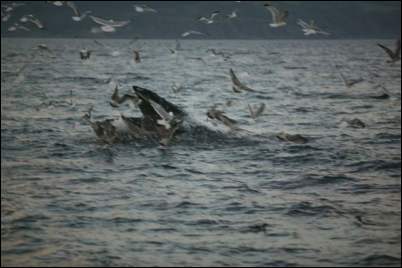
KNOYDART
The Games were particularly successful this year, with mild weather meaning everyone enjoyed wandering around the Long Beach field partaking of the usual eclectic selection of amusements on offer. Particularly notable was Drew's "Bet on Where the Pony Will Drop its Load" Game. Mark Harris had a particularly fine version of "Bash the Rat", and Tim and Hannah's Coconut Shy variations proved very popular. The Horizontal Bungee Run looked as amusing (and painful) as ever. Catering was provided by the Beveridges, who slaved over a hot barbecue, and the Peels, who manned the tea urn (whilst keeping an eye on my stall when I was being distracted by the latest events outside the marquee).
On the sporting front, we had a healthy uptake for the Tug-o-War (can't remember who won - doesn't really matter though, does it…) The Hill Race was won by the same tourist who has now been victor for last three years (he's got a 12-pack lager handicap next year). The Raft Race proved to be further reaching than previous years, with at least two of the rafts ending up at the pier half a mile away. The Dog Race was a tremendous display of canine ingenuity, cunning and dexterity, and will almost certainly be repeated next year as Knoydart folks and visitors attempt to demonstrate the capabilities of their pooches.
The Raffle, hosted by Roger, had prizes generously donated by the following people and organisations: Spar Mallaig, Co-op Mallaig, Johnston Bros., The Art Gallery, The Toy Shop, Got-It, the Harbour Master, Way Out West, The Tea Garden, The Fish Market, Highland Industrial Supplies (Fort William), The Cromag, The Knoydart Shop, Keith and Jean Peel, John and Janet Sellars, and Dave and Jan Marriott.
The ceilidh continued into the wee small hours that night. A heady mixture of dancing and drinking mixed with lively debate, and friendships were made, lost - and rekindled. A stunning sunrise heralded the end, with visiting stragglers making their way back home to B&B, bunkhouse or tent.
What else happened this month…oh yes: the whales. An amazing selection of marine life has been spotted recently, as many will know, and local boats were quick off the mark in taking people out whale-spotting. Particularly impressive was the Humpback whale, a giant of an animal, which treated onlookers to some amazing close-up displays. At times the easiest way to find the giant mammals was simply to follow the mini-flotillas of RIBs, yachts and other small boats out in the Sound of Sleat.
The new Lochaber Housing Association buildings at St Agatha's have eventually been allocated, which means that two local families now have secure, dry, warm and affordable accommodation. Everyone wishes Iain and Catriona, and Grant, Lorna, Kira and Freya all the best in their new homes.
Interviews for the position of Nursery Auxiliary are currently being conducted, and there it looks like there should be someone appointed fairly soon.
Well, over to Anne now. It's always good to get input from the older generation….oooops.
Tommy McManmon
Geoff Salt
I am told there is to be an article on Geoff in this month's West Word related to the publication of his book 'A Twentieth Century Life'.
Geoff, for those of us who have been living here for a while will know, as will those who have read his book, spent nine years in Knoydart at Harbour Cottage, which had originally been the SALT house at the time of the great herring catches. He is a man of many parts, astronomer, enameller, sailor, to name a few, and, in his book, relates many anecdotes with a local flavour, not least the one in which he refers to being "hoisted by his own petard"!
The book throws a personal angle on the history of the nineteen hundreds and is well worth reading for memory's sake.
Roger and I met Geoff recently sailing through Kyle Rhea and again at Plockton where we had a longer chat. This was Geoff doing what he has done for many years, spending four or five months sailing round the islands during the summer in his yacht Nyvaig.
I have added this piece although this month is Tommy's, since I believe Geoff had left Knoydart before Tommy arrived; and Tommy is almost too young to remember the twentieth century. Ooops! With best wishes to Geoff and all power to his writing elbow.
Anne Trussell
ISLE OF MUCK
August opened with a ceilidh and closed with a party - the pier opening party!
Wednesday 4th saw the Feis musicians in the school. They were a group of eight youngsters who were talented, enthusiastic, many played several instruments or sang. A concert was followed by a ceilidh and next day a number of islanders followed them to Eigg for a repeat performance. August's weather was not comparable to 2003 even though most of the ain fell on three days and was much less than much of Scotland. visitor numbers have been well down on last year though with loch Nevis calling there have been more on Tuesdays. The buoys at Port Mor have not encouraged more yachts to call although in the future it may make a difference when they are better known.
The last day of the month saw the opening of the new pier by Scottish Transport Minister Nicol Stephen, assisted by our eight scholars, though they may have been more to do with creating a photo-opportunity for the nation's press. There were speeches to be made and a plaque to be unveiled and a delicious lunch tobe consumed in the community marquee provided by Jenny and Ewen and numerous helpers. There were guests by the dozen (I have not yet had the tally) including Charles Kennedy who was making his second visit in a week! And the weather certainly behaved - it was the best day of the month and after lunch we sat in the sun until it was time for the Loch Nevis to call again and everyone to depart.
The other big event has been the wedding of Charlie MacKinnon to Marianna Sutherland. This really belongs to September and as I write the island is almost deserted as everyone is in Dingwall celebrating and there will be mor en October's west Word. But the stag night was August in Fort William attended by many from Muck. It started with a cruise on Loch Linnhe and continued in Lochaber Rugby Club. A good time appears to have been had by all - including Charlie!
On the farm it has been a month of successes and failures. No hay has been made this month though with two fields we got very close. On the other hand the silage and haylage tally reached almost 800 bales. The oat crop as mentioned last month is a fine crop, over 90% standing and just the right height for the binder. But it was not to be. The heavy grass growth caused by late ploughing, a low seeding rate and a short straw which did not shade it out prevented the oats coming evenly through the binder. The knotter did not have a happy time and we gave up after four rounds. It will be another challenge for next year!
The lamb sales have started and much to everyone's surprise prices have been up! The best lambs from the Mule ewes made £44.50. Even Gnasher's lambs which were loose coated and very Jacob made £34.50, considerably more than I expected.
Lawrence MacEwen
ISLE OF EIGG
After the disappointing July weather, it was a relief to experience a few hot days in August. Visitors coming to the island with the Sheerwater, the Brightwater or the Skye Seafari boats, were treated to multiple sightings of Minke whales and dolphins, whilst gannets were observed fishing very close to Eigg shores. The arrival of a Humpback whale in our waters got everyone very excited, and even made it to the national news, which is no wonder since it is at least 20 years since one of these leviathans was seen over here! Strangely enough, it has only been recently discovered why these whales have knobbly bits on their flippers and fins: by allowing more lift and less drag, these give the whale superior agility of movement to pursue its prey. Surely, sights like these should put the Small Isles on the map as a top cetacean watching destination!
The good weather was good for hay and silage making and a substantial number of black bales are now stacked for winter. With school starting again and uni looming near for our scholars, a great fun "end of summer" dance featured both old and young generations of island musicians: the Eigg button key accordion players and the Cormack brothers, equally at ease with percussion and lead guitar (that's what happens when you're brought up with a poster of Jimi Hendrix in your living-room!).
Meanwhile Eigg parents welcomed the news that the Mallaig hostel is going to go ahead. Warm thanks go to Sir Cameron Mackintosh for gifting the land (and his bright idea of adding a youth café to the building) and our councillor Charlie King for the part he played in securing this much needed facility for the Small Isles children, which should also become an asset for the Mallaig community. More thanks also go to Charlie for his role in securing the funding package for the Small Isles Piers which were inaugurated on August 31 by Nicol Stephen, Transport Minister in the presence of a good number of officials and councillors, including our prospective new MSP, Charles Kennedy. Alison Magee, the Highland Council Convener, stressed the Council's commitment to keeping remote areas populated and delivering economic development for all in the Highlands, whilst the minister reiterated the Scottish Executive's will to improve access throughout Scotland and particularly its most remote areas. It was slightly ironic that the unveiling of the plaque by the Eigg primary school children to the strains of Donna's pipes, took place as the Spanish John was unloading its fortnightly cargo at the old pier. Just as well that Charlie promised that ways and means of delivering cheaper freight in the future would be investigated! But it was certainly agreed by all that Colin Powell, the Council's engineer, his team who often worked beyond the call of duty on this project, and RG MacLeod have done a great job of the Eigg causeway and slipway. With the weather at its very best, it was a lovely day for all, complete with an obliging basking shark cruising between Eigg and Muck.
The outing to Muck where the inaugurating party took place, provided a good opportunity to ask Charles Kennedy's support for the Small Isles Medical practice which has been forced to opt out in the Out of Hours debacle.
Let's hope that he will be able to get the NHS bosses to see some sense!
Camille Dressler.
Kinloch Castle Friends Association
Eighteen members of the Kinloch Castle Friends Association (KCFA) travelled to Rum on 30th July. Our main project on this occasion was to tidy up the old dairy building which stands next to the site of the old Kinloch House, replaced 100 years ago by Kinloch Castle.
The weather while we were there was very good. We got all the exterior of the dairy building painted, and the surrounding ground tidied up. For this, SNH provided us with light blue disposable boiler suits with hoods. When we were walking about in these, a lot of the day visitors were giving us funny looks. We did look a bit like people dealing with a chemical attack or spillage. While this work was going on, other members assembled an outdoor seat which had been gifted by one of our members, and moved it to the riverside walkway at the south side of the Rockery Burn. This will give walkers an opportunity to rest, and enjoy the view of Kinloch Castle over the burn. Once the seat was safely installed, they went on to plant a number of rhododendron bushes to the rear of the castle. These are good quality non-invasive type bushes, donated by a garden centre in Perth, unlike the ponticum variety, which most estates including Kinloch, are now trying to eradicate.
Most of the party left on the Monday ferry. I stayed to do a bit of hill walking, and George Randall to continue his research in the castle.
The winter hay supply for the island arrived on the Wednesday morning ferry on a flatbed truck and trailer. All the community were involved in unloading the hay, and getting it under cover. I joined in. At first, I did not find the bails too heavy, but not being used to such work, they seemed to get progressively heavier, not helped by the fact that it was a very warm day. I gave up before the hay was fully unloaded, but in mitigation, I must say that at 62, I was by far the oldest person involved in this operation. The local grown hay had been baled and stored under cover the previous day.
Once again, the Rum Community were very welcoming and helpful. For that I would like on behalf of the Association, to thank them.
Douglas King, KCFA Secretary
Coastal Ranger Report
Yet again the dreaded end of the month sneaks up on me and the befuddled mind sends unintelligible messages to the brain in desperate hope that something might emerge with which to fill (almost wrote fool!) the monthly column.
After the fantastic sightings last month of the most obliging Humpback whale as well as multiple Minkies, Bottle Nosed Dolphins, Basking Sharks and, I'm told, even a Killer Whale in Glasnacardoch Bay, maybe we can actually claim that "Maritime" Lochaber is the place to come to! O.K. so I slipped in the "Maritime" bit again, but since I got no feedback on last month's suggestion that we christen ourselves as something distinct from Fort William, I just thought I would try it out again! I mean to say, if we look on "Lochaber" as being mainly Fort William area, "West Lochaber" as being the Ardnamurchan peninsula, shouldn't we have a "handle" as well? You never know, in the fullness of time even these dreadful weather forecasters on the BBC might attach a "moniker" to us and begin to realise that we do actually exist, and try a bit harder to give us an idea of what the weather might actually do, instead of the continual rain that they seem to think we are blessed with! I feel that my column is suddenly beginning to drift slightly towards a more political angle, so maybe I had best refrain from going any further and concentrate on matters in hand!!
Let me see now, walks have shown a considerable improvement in numbers since I last complained (do I moan all the time??) even reaching well into double figures on a couple of occasions, and it's all much more entertaining when I have a decent group with a bit of banter here and there. The slight drawback with the bigger groups is obviously the noise factor which limits the likelihood of any wildlife sightings, but we do usually manage something, even if it is only a few deer. The only unusual sighting for me this month, apart from the aforementioned marine carnival, was an excellent look at a most obliging Hen Harrier (it sat sublimely uncaring on a rock for long enough for me to make a positive identification!). I have no doubt that Stephen has seen Harriers around here fairly often, but it's a first for me, so I'm quite chuffed! Mind you when I told him he just said "Hmmm, was it a female?" O.K. so I am not that smart! I'm only a Ranger after all!! While I'm still on the subject of walks, there is a slight change to my programme. On the handout leaflets there are no walks scheduled for the first week of September as I expected to be wielding my golf clubs in our annual escape to Ireland, however, things have changed and I will not be going on holiday until October (don't anybody dare say "more holidays!"). Thus I will be doing a further three walks at the start of the month, which will be advertised on the posters as usual, and are already in the "What's On". Bookings welcome!
Finally, I would just mention, in passing, the Arisaig Regatta, which this year could not be run for last minute complications with insurance on the big boats. As you no doubt heard, the "Family Dance" went ahead as planned and was it's usual success, but some quite drastic changes will have to be made to the sailing and the "Fun Day" if the Regatta is to survive. To this end, the existing committee needs to be bolstered with some new blood and some fresh ideas, and is looking for some volunteers (always a dirty word!). If you can help in any way, I believe that there will be an open meeting in the near future, so please show some enthusiasm, as we need to foster anything that helps to entice more visitors to the area.
Well that's it for this month, look after yourselves and feel free to contact me, or my electronic genius, on 01687 462 983 at any time.
Angus Macintyre
Auntie Mary's Creepy Crawly Corner
Thanks to John for September's question.
Is the Ptarmigan the only grouse in Scotland to turn white for winter camouflage ?
Yes, not only is it the one member of the grouse family in this country to change into winter plumage, it is also the only British resident bird which does this.
There are 4 species of grouse living in the British Isles : the Ptarmigan, Red Grouse, Black Grouse and Capercaillie. The males in breeding plumage have red combs above both eyes.
All nest on the ground where the dappled plumage of the hen provides good camouflage. These plump birds have short convex bills, feathered nostrils, short legs and feathered feet; all adaptations which enable them to live in cold or exposed habitats. Adults are vegetarians while young chicks will also eat insects and other creepy crawlies.
Ptarmigan, from the Gaelic tarmachan, are about 35cm (14 inches) length beak to tail. In summer the cock is speckled grey with pure white wings and black tail tips, the hen is mainly mottled greyish brown which renders her very-well camouflaged in montane heath with rocks habitats. In the autumn both cock and hen moult into winter plumage which is pure white with black tail tips. They are monogamous and live around the summits of higher hills in the Highlands, such as those around Ben Nevis and on the broad plateaux tops in the Cairngorms. Ptarmigan feed on heather, other dwarf shrubs, blaeberry and sedges.
Red Grouse are about the same size as Ptarmigan. These rusty-reddy-brown grouse live on moors, and heather-clad hills where their predominant food is young heather shoots. This is one reason why keepers carry out systematic muirburn to encourage the growth of young heather for the grouse to feed on. Like others in the grouse family, they rely on their effective camouflage to escape predators and only fly short distances. They are monogamous, with the male fiercely defending his territory. Their famous 'go-back' call is often heard at this time of year on the moors, more to the east in Lochaber as the wetter conditions to the west offer not such favourable habitat.
Black Grouse males (blackcock) grow up to about 60cm in length and the female (greyhen) to about 45cm. Black cock plumage is spectacular : the glossy black, with blue or green reflections, contrasts with the white on the wingbar and undertail feathers. The peculiar lyre-shaped tail has long outer feathers which curve outwards, giving these males their distinctive display silhouettes. The greyhen, as her name suggests, is brownish-grey with black mottling which makes her well-camouflaged for egg incubation. Blackcock are polygamous and the communal mating ground, called a lec, is found in open ground such as a grassy woodland edges or clearings. The males joust for the attention of the females, with their tail feathers erect and spread, and uttering a prolonged bubbling sound which is sometimes interrupted by a loud scraping call. The blackcock holding territories in the centre of the lec secure more mates. Black grouse tend to eat birch, willow, pine or young spruce buds in winter, while in summer their diet is more varied with heather other shrubs, blaeberries and other fruit, stems and shoots.
Capercaillie derives from the Gaelic capull-coille 'great cock of the wood'. The cocks may grow to 80-115 cm in length, and the hens to 60 cm. The large male is mainly slate grey with fine striations, they have a blackish head and neck, the breast glossy greenish black, with dark brown wings, and variable amounts of white on the underside and in the tail feathers. The tail is long and rounded. The female is barred and mottled buff, black, grey and white; with a large rusty patch on the breast. The cock is polygamous, making a flamboyant and noisy display by standing on a boulder with tail erect and fanned, bill pointing upwards, and calling.
In Scotland Capercaillie live mainly in pinewoods, feeding on pine needles and buds of blaeberry and heather in winter. When available they also eat buds, shoots, berries of juniper and dwarf shrubs, sedges, horsetails and mosses. They were shot to extinction in Scotland by 1785 and re-introduced from Sweden to Perthshire in 1837.
Ref : Handbook of the Birds of the World Vol 2. 1994, editors : Del Hoyo, Elliott, Sargatel.
Dr Mary Elliott
Birdwatch by Stephen MacDonald
August was a pretty normal month in the bird world, although two sightings of single Sooty Shearwaters in Rum Sound were good finds.
Up until the last week of the month, good numbers of other seabirds could be seen feeding just offshore from Mallaig and Arisaig. These were large groups of Guillemots, Razorbills, Manx Shearwaters and Kittiwakes, plus a few Gannets and the odd Great and Arctic Skua. Storm Petrels were seen throughout the month, with some even blown into Loch nan Ceall, Arisaig, along with Guillemots at the end of the month.
Small numbers of waders continued to pass through the area, with some stopping to rest and feed for a while. On the 10th, these were 25 Golden Plovers, 10 Dunlin, 8 Ringed Plovers, 4 Sanderling, 3 Greenshank and 1 Turnstone, all on the shore by Traigh boat-house. On the 11th, 14 Sanderling were seen at Traigh and 3 Turnstones and 2 Redshanks were on the rocks of the West Bay car park, Mallaig. A single Knot was seen among a few Dunlin at Traigh on the 24th and at least 10 Turnstones were on the rocks at West Bay car park on the 27th.
Red Throated Divers were seen regularly during the month and 3 Great Northern Divers, already in winter plumage, were seen off Traigh on the 10th. Up to 30 Greylag Geese were seen at Traigh on the 23rd.
Flocks of Twite and Linnet were seen at Back of Keppoch and Traigh, while Greenfinches and Bullfinches were seen at Morar, feeding on ripening Rowan berries.
A Merlin was seen at Rhue on the 3rd, while Sparrowhawks and Buzzards were seen frequently in both Arisaig and Morar.
Two flocks of Swifts, both of about 30 birds, were reported late in the month, one over Arisaig ad the other over the sea between Eigg and Arisaig.
Finally, there were reports of a Jay in Arisaig during the month. This is a member of the Crow family and is uncommon in the NW Highlands, although increased reports in recent years suggest that its breeding range may be spreading Westwards.
The Canoe Club's Summer Cruise 2004: Part II
At the end of last month's account our intrepid band of sixteen paddlers had met at Craignure and commenced their circumnavigation of the Isle of Mull. So how did it all go? Rather than respond in the usual diary form, I have gathered my comments into issues, most of which had seriously concerned us before we departed.
Wildlife:
Disappointingly, we did not see any of Mull's sea eagles, but we did have exciting close views of otter, mink and wild goats.
Reports in the press would have had us believe that many species of sea bird, especially those that depend upon sand eels for food, had suffered from a very poor breeding season and had consequently departed for the far north. So far as we could tell, there seemed the usual numbers of guillemots, razorbills and puffins in the area, many of whom had young in attendance.
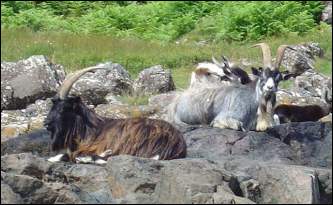
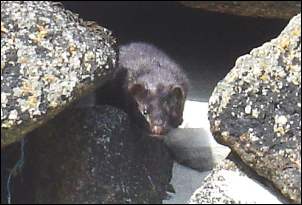
Wild goats and a vicious mink
Weather:
I think "variable" sums it up best. We experienced some rain and some sun, but not a lot of either. Mostly it was just cloudy and quite cold, with fresh breezes on most days. What was remarkable was that despite this, we never had to pitch or strike our tents in the rain, nor did we have a wet lunchtime. Indeed, the winds were kind enough to permit us to paddle on eight consecutive days (an almost unheard of event!) It was a near thing on the middle Wednesday, however, for we were forced to delay our start from Ulva until after midday to allow the seas, whipped up by a strong westerly breeze, to die down a little.
Route:
From the earliest stages, the three-knot, spring flood tides at Duart Point had dictated the strategy for getting round Mull. We calculated that if adverse winds forced us into an anticlockwise journey, we would have ended the week at Duart Point having to face formidable spring tides, possibly with significant overfalls due to wind against tide. However, a clockwise journey with a late start on the first Saturday, meant passing Duart Point at slack water neaps, with a developing ebb tide to assist us to our first campsite. This clockwise route also meant that later in the week we had flood tides in the middle of the day that pushed us north along Mull's exposed west coast. Thus, once we had looked carefully at the alternatives, there was little choice.
Campsites:
Perhaps because we had been so apprehensive about finding sufficient sites for our large group, we ended being prepared to accept less than ideal locations. We discovered the sites didn't have to be billiard tables of sheep shorn grass alongside clear, bubbling rills. Provided the slope was not severe and the site was not too exposed to the elements, we were happy. Indeed, for most evenings there was no shortage of space. At the end of the day, when the kayaks were beached, the paddlers seemed to explode and rapidly occupy the available space, maximising the distance between tents as though everyone was afraid that they snored so loudly that they would keep everyone else awake.
Safety:
The conditions we faced during the week tested the skills of leaders and participants alike. Perhaps because the elements combined with the unfamiliar and spectacular geography in so dramatic a fashion, there was little indication from the club members of their usual paddling vice, namely, a tendency to disperse widely, indeed almost to the limits of vision. Instead, a single, large, but amorphous group was in evidence for most of the time, but this became a really cohesive, diamond formation whenever the seas kicked up and we needed mutual support to deal with any potential emergencies. As it happened, it was the boats, not the people that produced the emergencies and it was a matter of great satisfaction that all the necessary repairs were effected in a quite straightforward manner.
Goals:
We did manage to spend some time exploring Iona and Staffa, and those that wanted to, entered Fingal's Cave, but because of threatening weather we were stymied from both exploring Staffa further or from reaching the Treshnish Isles. Despite this, I think it fair to say that all enjoyed themselves (at least for most of the time) and there was little doubt that participants felt a real sense of achievement in circumnavigating the Isle of Mull.
Conclusion:
Whilst we are sure that other groups will have paddled round Mull in much faster times, we do wonder if there have been parties larger than sixteen who have tackled this challenge. We are pretty sure, however, that given Rebecca's and Joe's ages (eleven and seventy-three, respectively) there was never a kayak trip round Mull with a wider age range!
The "Sixteen":
From Lochaber: Mark Evans and Pauline McGinnes; Mike and Sheila Kingswood; Tony and Elizabeth Laidler; Roger Lanyon.
From further afield: Chris Carter (Shropshire); Ed Engels and Joe Mullen (Florida, USA); Simon Sims (Strontian); Bill, Jill and Rebecca Skeogh (Fort Augustus); Alex and Suzanne Turner (Skye).
A. Paddler
Pictured above: Seumas Macdonald (left), Manager of Caledonian MacBrayne in Mallaig, presenting the Cal-Mac Trophy to Chick Young, Captain of the Dukla Pumpherston team, after the Mission Weekend Challenge Match.
Chick Young announced his wish to bring his team back next year and suggested the cup might be renamed the Davie Armour/Cal-Mac Trophy in memory of their team-mate who had passed away two days before the match.
A Little Genealogy by Allan MacDonald (email: ealasaid6@btopenworld.com)
A few weeks ago Elizabeth came across a posting from Cheryl Reed in Queensland, Australia. She was seeking information on her g.g.g. grandparents, Angus MacNeil and Mary Grant who were married in Ayrshire in 1834. Angus MacNeil was born in 1808, in Moidart. Angus, Mary and their 6 children, late of Dalnabreac, Moidart, emigrated to Australia in 1852, on the Araminta. One child, Flora, aged 1 year, died en route.
Mary Grant's parents were, Hugh Grant, weaver, born in Arisaig in 1768 and Mary MacKinnon. In 1841 Mary and Hugh Grant were living on the Rhu peninsula with a daughter, Janet, aged 20 years.
In 1861, Hugh was still alive in in Dalnabreac with two of his children, Catherine, aged 30 and John, aged 38 . Boarding with them was a Margaret Grant, aged 40. No relationship is recorded, but it seems likely that Margaret was a relative as all were born in Arisaig.
John Grant married Margaret ? (possibly MacIsaac) from Acharacle and in 1861, they had had at least 3 children, Peter 6, Sarah 4, and John 3.
In 1881, John and Margaret were in Dalilea and the children are with them.
Their son, Peter Grant married ? and had 7 children. Angus, Margaret, Kate, Sarah, John, Joan and Dugald.
Peter's daughter, Margaret Grant married John Cameron from Arivegaig and their children were, Bella, Dugie, Mary, Ellen, Donalda and Morag. (Not necessarily in that order).
Bella married Donald Macrae from Roshven and they had 2 children, Donald, (Doshie) and Peggy.
Morag Cameron married Iain MacLellan, a fine piper and musician, from Eilean Shona, and had 3 children, Margaret, a Mod Gold Medalist, James, of "Moidart Engineering" and John.
Sometime ago, I wrote an article about the "Loddies" of Arisaig and Canada - so-called after Ludovic MacDonald of Suin as Leitir. Ludovic was married to Mary, daughter of Donald Grant, Kinloid. There is a strong possibility that Hugh Grant, b, 1768 in Arisaig, was a brother of Donald, who emigrated, to Canada in 1790, on the Jane.
Cheryl Reed would be delighted to receive any information on the above MacNeils and Grants or any of their descendants. You can contact Cheryl at: reedcheryl@optusnet.co.au or give me a ring at: 01687 450 604 and I can get in touch with her.
Back to Their Roots
Around the turn of the century, at Kylesknoydart, tucked away against the hillside and facing Loch Nevis stood a little, two storey house with its byres and sheds. The family living there at the time were Angus and Mary MacDonald, their seven children and Angus's brother John. The family were crofters and Angus and John were also fishermen.
Over a century later, on 9th August 2004, six of their descendants - Joanne MacDonald and her children Brett and Jilly, and Gail Friesan, all from Alberta, Canada and Agnes Clark and her daughter Eilidh from Edinburgh - made the journey back to Knoydart accompanied by Agnes' husband Ian.
They set off up Loch Nevis at 10.30 am in the pouring rain in the Grimsay Isle ably skippered by Ewen Nicholson. The first stop, two hours later, was at Kylesknoydart, viewed with difficulty through the mist. One quick and smooth transfer by Ewen's cobble to the shore and one not so quick and rather tortuous hike through chest high grass, big and burn brought them finally to the front door of the house which is still totally intact.
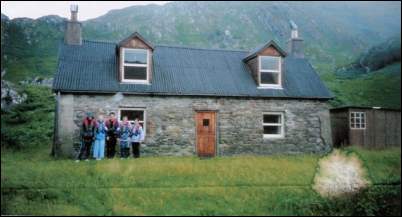
Five of the party outside Agnes' grandmother's house
Angus and Mary MacDonald called their eldest daughter Mary and their youngest son Angus.
The daughter Mary left home to work in Edinburgh, married and had two children. Sadly she returned to Kylesknoydart when she became terminally ill and died there at the age of 41. she was Agnes' grandmother and Eilidh's great-grandmother.
The son Angus survived active service in the First World War, came home then emigrated to Canada. He married a Scots girl, raised a family of six and died at the age of 88. he was Joanne and Gail's grandfather and Brett and Jilly's great-grandfather.
And so, some of the descendants of the MacDonalds came back to look at the family home and take photographs and marvel at the isolated and wild place where their ancestors lived and died and which is part of their family history.
It was, perhaps, even more poignant for Agnes, whose mother and uncle (children of the daughter Mary) were brought up there by their grand-parents, and who went to school each day rowed across the narrows by their grand-father.
Unfortunately, although the house is inhabited, there was no-one at home so the visitors were unable to view the interior but, despite being soaked to the skin and eaten alive by midges, all declared the visit (or should we say the. pilgrimage) very well worth making.
Our intrepid travellers made two more visits that wet day. The first was to Donald MacDonald at Tarbet, who at the age of 90 is Loch Nevis's oldest inhabitant. Donald knew and remembered the MacDonalds very well and their grandchildren were delighted to be able to chat with him about them for a short time.
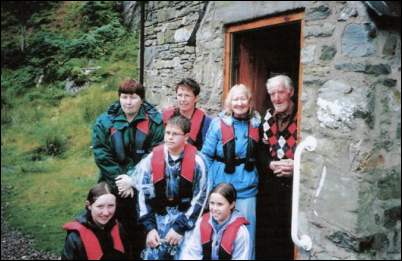
With Donald at Tarbet
The last stop was Inverie where most of the party thankfully dried out a bit in the pub while Joanne and Agnes set out to find the 2 small graveyards in the field just out of the village. Donald thought that their great-grandparents and Agnes' grandmother were buried there. Unfortunately there were no gravestones with family names in one of the graveyards. From what they were able to see over the wall of the other graveyard, the headstones visible there, among te long grass, seemed rubbed smooth by the elements. They didn't dare venture in for a closer inspection as a Highland Cow had taken up residence just inside the gate and was eyeing the pair with more than a little interest!
Nevertheless the day was deemed a great success as on of the main objectives of the Canadians' visit to Scotland had been realised and all felt the had truly gone back to their roots.
Our thanks to Agnes Clark for this account of their trip.